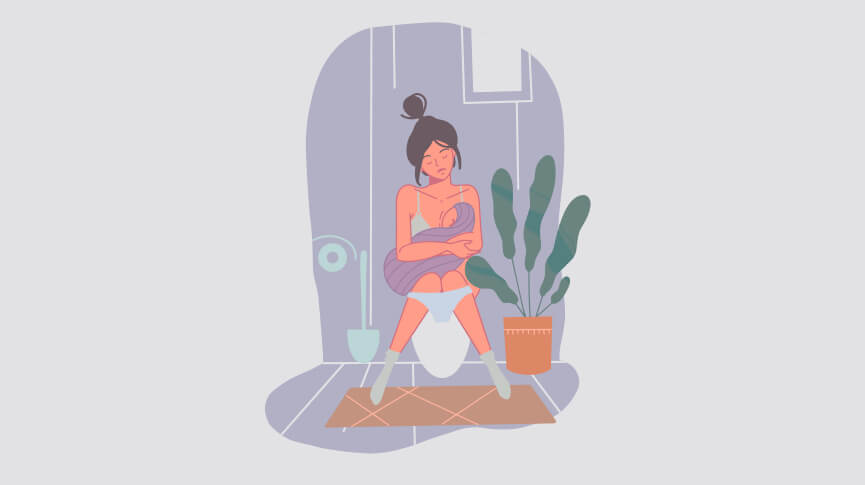Postpartum Bleeding: Have You Ever Heard of Lochia?

If you’re reading this, you’re most likely pregnant, recently postpartum, or are just very curious about reproductive health. Either way – congratulations! Pregnancy is a wild ride. It can do all sorts of fun things to your body. That’s just what it takes to make a whole human from scratch. The fun doesn’t stop after birth. Postpartum comes with all sorts of surprises and changes. One of those changes is the appearance of lochia after birth.
What is Lochia?
Your body goes through so many changes immediately after birth. Lactation kicks up, your uterus starts to return to its normal size (involution), you might experience constipation, and of course – postpartum bleeding. Postpartum bleeding, also called lochia, may resemble period blood, but there are quite a few differences. Lochia is postpartum vaginal discharge that comes from the cervix, uterus, and vagina. The other big difference is that menses, period blood, happens after ovulation as part of the menstrual cycle. Whereas lochia is how the body sheds uterine lining, endometrium, mucus, and other stuff that builds up during pregnancy. This extra blood and tissue were used to help your baby grow, but it’s not needed anymore.
Lochia is a part of the postpartum process where you had a cesarian section of vaginal birth. People who had a cesarean section, however, might have less lochia after twenty-four hours postpartum than someone who had a vaginal birth. The color and consistency of lochia changes as the days go on postpartum. Here’s a breakdown of what lochia tends to look like from day to day:
Day One to Four: Lochia in this stage is made up of blood, parts of the mucous membrane that lines the uterus during pregnancy (decidua), mucus, and endometrial tissue.
Day Five to Nine: Lochia during these days tends to be watery and pinkish, pale brown or yellowish. It’s made up mostly of mucus, blood, and leukocytes – aka white blood cells.
Day Ten to Fourteen: Lochia at this point in the postpartum period tends to be pale yellow or white, containing mostly mucus.
These stages are just estimates and can vary from person to person.
How Long Does Lochia Last?
Lochia tends to last between two to six weeks postpartum. You may notice an increase in the amount of lochia while you’re lactating, physically active, or when you get up in the morning. Postpartum bleeding tends to be heaviest the first few days postpartum.
How Do You Manage Lochia?
Postpartum is a time to rest, recuperate, and bond with your sweet new baby (or babies). All of your energy is probably focused on feeding your baby, staying hydrated, and catching some zzzs when you’re able to. Unfortunately, you’re probably also dealing with leaking and discharge. Both from your nipples and vagina. In an effort to make this as easy as possible, you’ll want to try to stock up on some supplies before giving birth, if you’re able to. If you give birth at a hospital, they’ll most likely send you home with some not-so-sexy adult diapers. You may want to buy more of these ahead of time, or the biggest pads you can find. A more sustainable option is to use period panties or reusable pads. You’ll want to avoid using tampons or a menstrual cup, as you are at an increased risk of infection in the immediate postpartum period. Although they’re a great option once you start to get your period again! Other ways you can help set yourself up for success in postpartum are getting a great mattress protector and using sheets you don’t care too much about.
Is There Anything to Watch Out For?
While lochia can vary from person to person, and pregnancy to pregnancy. There are some things to keep in mind.
Here’s what you should watch out for postpartum:
- Red lochia after five days postpartum
- Bad or foul-smelling vaginal discharge
- Heavy bleeding after the first few days postpartum
- Large pieces of tissue or blood clots bigger than a golf ball
- Absence of lochia
- A fever over 100.4 degrees Fahrenheit
- Severe chills
- Severe cramping or abdominal pain
- Severe headaches, blurred vision, or fainting
- Difficulty breathing
If you experience any of these symptoms, contact your healthcare provider immediately. Once you’re home, if you find that you have more lochia after being up and moving around, try to rest as much as you can. This is a great time to delegate tasks to any visitors who are swinging by. Give everyone a job, even if it’s just washing dishes or taking the dog out. Your job right now is to heal, rest, and care for your baby. If you have any further questions on lochia, vaginal discharge, or other changes to your body postpartum, be sure to talk with your medical provider.

Natasha (she/her) is a full-spectrum doula and health+wellness copywriter. Her work focuses on deconstructing the shame, stigma, and barriers people carry around birth, sex, health, and beyond, to help people navigate through their lives with more education and empowerment. You can connect with Natasha on IG @natasha.s.weiss.


